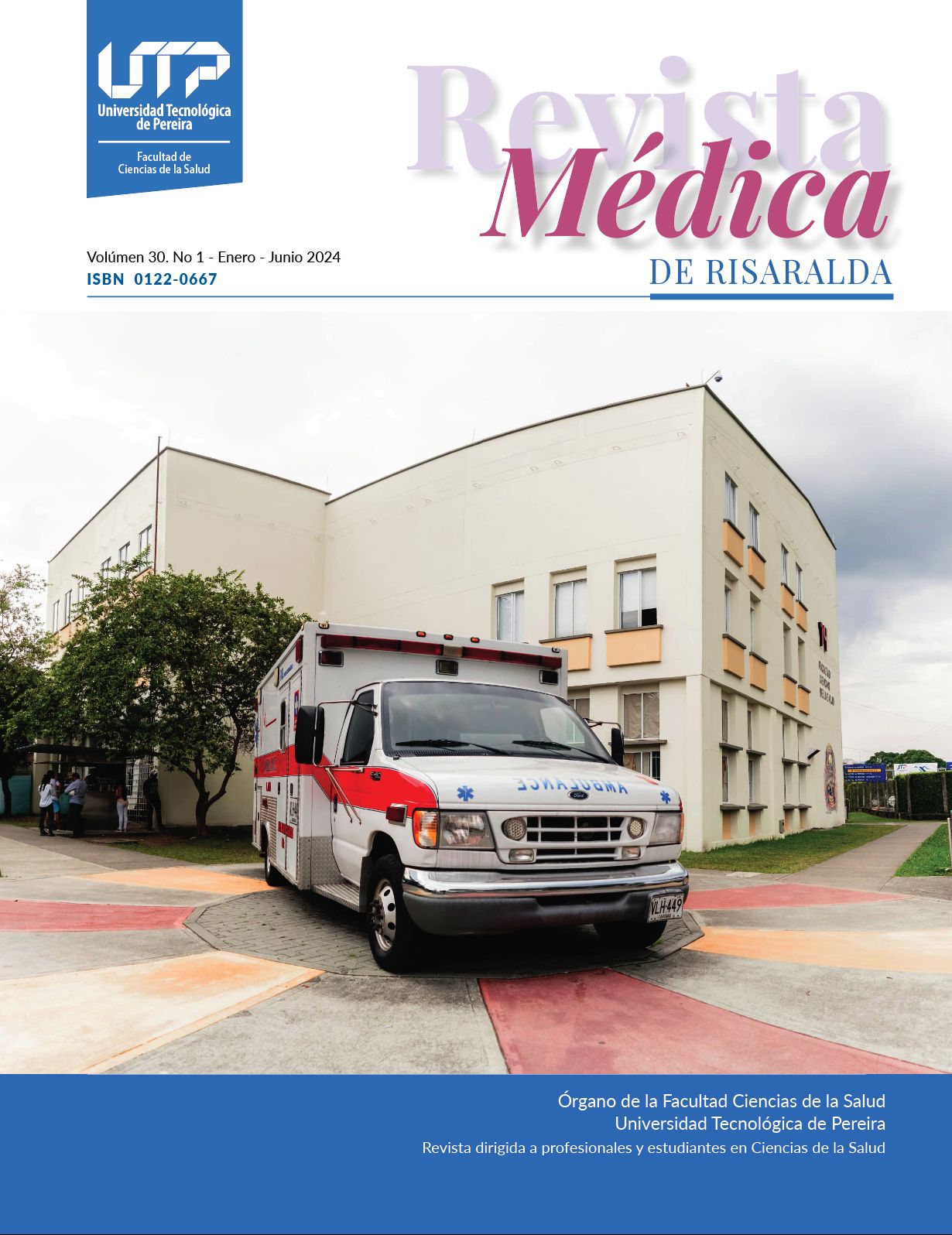Probability of anemia in pre-diabetics and diabetics: analytical study carried out in a medical center in Villa el Salvador, Lima-Peru
DOI:
https://doi.org/10.22517/25395203.25338Keywords:
Anemia; Hyperglycemia; Odds Ratio; Adulto; Diabetes MellitusAbstract
Introduction: The World Health Organization estimates that 2 billion people suffer from anemia, while pre-diabetes and diabetes affect approximately 352 and 460 million people, respectively. Anemia is a frequent complication in diabetes mellitus.
Objective: To evaluate the association and probability of hemoglobin alterations in pre-diabetics and diabetics.
Methodology: Descriptive, retrospective and cross-sectional study, the population was 1103 patients (211 prediabetics, 223 diabetics and 669 normoglycemics), the sample was the total population that met the inclusion and exclusion criteria: normoglycemic and prediabetic adults without presence of acute or chronic disease at the time of examination. The association between variables was performed using the chi-square test and the probability was determined by the Odds Ratio test.
Results: Pre-diabetic women had a 1.72 higher probability of anemia than non-diabetic women. Pre-diabetic men were 2.80 times more likely to have anemia than non-diabetics. Diabetic women were 2.37 times more likely to have anemia, while diabetic men were 4.41 times more likely than non-diabetic men to have anemia.
Conclusions: Pre-diabetic patients are more likely to have anemia than non-diabetics. It is possible that persistent hyperglycemia in pre-diabetics is associated with changes in the concentration of this hemoprotein years before the development of diabetes by similar mechanisms, but in an incipient manner.
Downloads
References
Safiri S, Kolahi A-A, Noori M, Nejadghaderi SA, Karamzad N, Bragazzi NL, et al. Burden of anemia and its underlying causes in 204 countries and territories, 1990-2019: results from the Global Burden of Disease Study 2019. J Hematol Oncol [Internet]. 2021[citado 5 de diciembre de 2022];14(1):185. Disponible en: http://dx.doi.org/10.1186/s13045-021-01202-2
Zheng Y, Ley SH, Hu FB. Global aetiology and epidemiology of type 2 diabetes mellitus and its complications. Nat Rev Endocrinol [Internet]. 2018 [citado 5 de diciembre de 2022];14(2):88–98. Disponible en: https://pubmed.ncbi.nlm.nih.gov/29219149/
Taderegew MM, Gebremariam T, Tareke AA, Woldeamanuel GG. Anemia and its associated factors among type 2 diabetes mellitus patients attending Debre Berhan Referral Hospital, North-East Ethiopia: A cross-sectional study. J Blood Med [Internet]. 2020 [citado 5 de diciembre de 2022];11:47–58. Disponible en: http://dx.doi.org/10.2147/JBM.S243234
Mokgalaboni K, Phoswa WN. Cross-link between type 2 diabetes mellitus and iron deficiency anemia. A mini-review. Clinical Nutrition Open Science [Internet]. 2022 [citado 5 de diciembre de 2022];45:57–71. Disponible en: https://www.clinicalnutritionopenscience.com/article/S2667-2685(22)00047-X/fulltext
Cassidy FC, Shortiss C, Murphy CG, Kearns SR, Curtin W, De Buitléir C, et al. Impact of type 2 diabetes mellitus on human bone marrow stromal cell number and phenotypic characteristics. Int J Mol Sci [Internet]. 2020 [citado 5 de diciembre de 2022];21(7):2476. Disponible en: https://www.mdpi.com/1422-0067/21/7/2476
Atlaw D, Tariku Z. Magnitude and factors associated with anemia among diabetic patients in Ethiopia: A systematic review and meta-analysis. SAGE Open Med [Internet]. 2021[citado 5 de diciembre de 2022];9. doi:10.1177/20503121211031126
Diabetes standards of care 2022 [Internet]. Guideline Central. 2021 [citado 5 de diciembre de 2022]. Disponible en: https://www.guidelinecentral.com/guideline/14119/
Akbarpour E, Paridar Y, Mohammadi Z, Mard A, Danehchin L, Abolnezhadian F, et al. Anemia prevalence, severity, types, and correlates among adult women and men in a multiethnic Iranian population: the Khuzestan Comprehensive Health Study (KCHS). BMC Public Health [Internet]. 2022; citado 5 de diciembre de 2022]22(1):168. Disponible en: http://dx.doi.org/10.1186/s12889-022-12512-6
Erez D, Shefler C, Roitman E, Levy S, Dovrish Z, Ellis M, et al. Anemia in patients with diabetes and prediabetes with normal kidney function: Prevalence and clinical outcomes. Endocr Pract [Internet]. 2022 citado 5 de diciembre de 2022];28(2):129–34. Disponible en: https://www.sciencedirect.com/science/article/pii/S1530891X21012908
Fujikawa T. Central regulation of glucose metabolism in an insulin-dependent and -independent manner. J Neuroendocrinol [Internet]. 2021 citado 5 de diciembre de 2022];33(4):e12941. Disponible en: http://dx.doi.org/10.1111/jne.12941
Zhao J, Wu Y, Rong X, Zheng C, Guo J. Anti-lipolysis induced by insulin in diverse pathophysiologic conditions of adipose tissue. Diabetes Metab Syndr Obes [Internet]. 2020 [citado 5 de diciembre de 2022];13:1575–85. Disponible en: https://www.dovepress.com/anti-lipolysis-induced-by-insulin-in-diverse-pathophysiologic-conditio-peer-reviewed-fulltext-article-DMSO
Weil EJ, Kobes S, Jones LI, Hanson RL. Glycemia affects glomerular filtration rate in people with type 2 diabetes. BMC Nephrol [Internet]. 2019;20(1):397. Disponible en: http://dx.doi.org/10.1186/s12882-019-1584-7
Zeni L, Norden AGW, Cancarini G, Unwin RJ. A more tubulocentric view of diabetic kidney disease. J Nephrol [Internet]. 2017;30(6):701–17. Disponible en: http://dx.doi.org/10.1007/s40620-017-0423-9
Santopaolo M, Gu Y, Spinetti G, Madeddu P. Bone marrow fat: friend or foe in people with diabetes mellitus? Clin Sci (Lond) [Internet]. 2020 [citado 5 de diciembre de 2022];134(8):1031–48. Disponible en: https://portlandpress.com/clinsci/article-abstract/134/8/1031/222769/Bone-marrow-fat-friend-or-foe-in-people-with?redirectedFrom=fulltext
Downloads
-
Vistas(Views): 358
- PDF (Español (España)) Descargas(Downloads): 139
- PDF Descargas(Downloads): 52
Published
How to Cite
Issue
Section
License
Cesión de derechos y tratamiento de datos
La aceptación de un artículo para su publicación en la Revista Médica de Risaralda implica la cesión de los derechos de impresión y reproducción, por cualquier forma y medio, del autor a favor de Facultad de Ciencias de la Salud de la Universidad Tecnológica de Pereira. 1995-2018. Todos los derechos reservados ®
por parte de los autores para obtener el permiso de reproducción de sus contribuciones. La reproducción total o parcial de los trabajos aparecidos en la Revista Médica de Risaralda, debe hacerse citando la procedencia, en caso contrario, se viola los derechos reservados.
Asimismo, se entiende que los conceptos y opiniones expresados en cada trabajo son de la exclusiva responsabilidad del autor, sin responsabilizarse ni solidarizarse, necesariamente, ni la redacción, ni la editorial.
Es responsabilidad de los autores poder proporcionar a los lectores interesados copias de los datos en bruto, manuales de procedimiento, puntuaciones y, en general, material experimental relevante.
Asimismo, la Dirección de la revista garantiza el adecuado tratamiento de los datos de carácter personal



